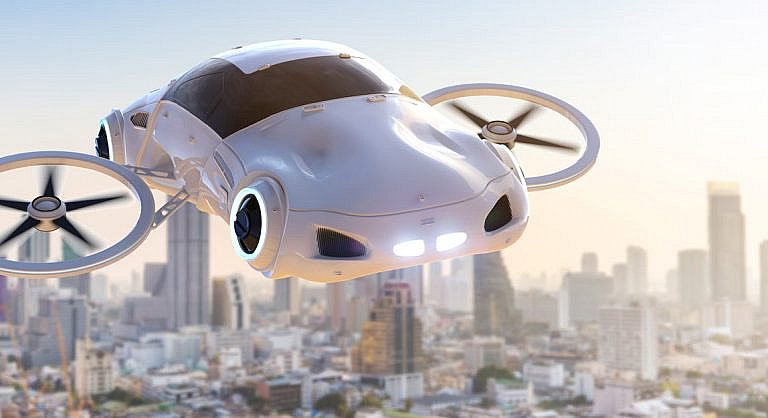Imagine zooming through traffic on your daily commute, not on a traditional road but in the air, above the congested streets, bypassing the chaos below. This dream may not be as far from reality as it seems. The concept of flying cars has been a part of futuristic visions for decades, from science fiction films to speculative technologies. However, recent advancements in engineering, aerodynamics, and technology suggest that the flying car, once seen as a mere fantasy, is on the brink of becoming a reality. But what exactly is a flying car, and how close are we to seeing them in the skies?
The Genesis of the Flying Car
The idea of a flying car is not as modern as one might think. The very first mention of a flying car comes from the early 20th century when inventors and visionaries began imagining a future where personal transportation would transcend roads. The notion was first introduced by the legendary American inventor, Henry Ford, who in 1926 expressed his belief that the future of transportation would include vehicles capable of flying. His vision was not entirely grounded in fantasy—after all, he had already revolutionized the automobile industry with the Model T.
One of the earliest attempts at creating a flying car was the Moller M400 Skycar, which began development in the 1980s by Paul Moller, a Canadian-American engineer. Despite several prototypes, the technology of the time was simply not advanced enough to make such a vehicle commercially viable. However, this did not deter other engineers and visionaries, and over the decades, flying car concepts continued to emerge.
But how does a flying car differ from conventional vehicles or aircraft? The key feature of a flying car is its ability to operate both as a terrestrial car, traveling on roads, and as an aircraft, soaring through the skies. Unlike helicopters or planes, which require designated landing zones or runways, a flying car aims to be compact enough to land and take off in smaller, more practical areas.
The Technological Building Blocks
Several technologies must come together to make a flying car feasible. Let’s break down some of the key components:
1. Power Sources
For a vehicle to fly, it needs power. Early flying car prototypes relied heavily on combustion engines. However, with advancements in electric propulsion, modern flying cars are being developed with electric engines, particularly vertical takeoff and landing (VTOL) designs. These electric engines are not only more environmentally friendly but also offer greater flexibility when it comes to flight in urban environments, where emissions need to be minimized, and noise pollution must be controlled.
Battery technology has also seen significant improvements in recent years, with electric vehicles (EVs) becoming increasingly mainstream. As battery technology improves, particularly with regard to energy density, flying cars will have longer ranges, better power efficiency, and quicker charging times. This makes the dream of flying cars more attainable than ever.
2. Aerodynamics
Aerodynamics plays a pivotal role in the development of flying cars. For a flying car to be efficient and safe, its design must ensure that it can both travel on roads and generate sufficient lift when transitioning into flight. Engineers must balance factors like drag, weight, and lift to create a vehicle that is capable of operating in both environments.
The designs for flying cars generally fall into two categories: tilt-rotor and fixed-wing. Tilt-rotor vehicles have rotors that tilt to provide both vertical lift and horizontal thrust, while fixed-wing designs have wings that generate lift and require forward motion to stay airborne.
3. Autonomous Navigation and Control
Perhaps one of the most challenging aspects of the flying car revolution is navigation and control. In the early days of aviation, aircraft pilots had to rely on their manual skills to navigate the skies. Today, however, many aircraft are equipped with autopilot systems that assist pilots with flight management. Flying cars will likely rely heavily on autonomous systems to navigate congested airspaces safely.
Autonomous flying cars would need to integrate with air traffic management systems, both for aviation and for urban areas. Real-time data about weather, traffic, and obstacles in the environment would be crucial for their operation. A robust communication network would also be essential to ensure that flying cars could avoid collisions and manage traffic effectively, much like modern self-driving cars rely on sensors and machine learning algorithms.
4. Safety Mechanisms
Safety is paramount for any vehicle, but even more so for one that operates in the air. With the added complexity of flight, flying cars must come with multiple safety features to ensure their stability and reliability. Modern flying cars may come equipped with parachutes, backup propulsion systems, and autonomous emergency landing features. Additionally, advanced sensors, radar systems, and collision-avoidance technologies will be necessary to help flying cars navigate safely.
Even though the idea of flying cars may seem thrilling, it’s crucial that manufacturers prioritize safety. This includes designing vehicles that can withstand extreme weather conditions, unexpected malfunctions, and unplanned landings.
The Current State of Flying Cars
Several companies and organizations are currently working on making flying cars a reality. As of the 2020s, multiple prototypes have been revealed, and tests are being conducted worldwide. While we are not yet able to see flying cars populating the skies, the progress made so far is impressive. Below are some of the most notable developments in the field:
1. Terrafugia Transition
Founded in 2006, Terrafugia has been one of the pioneers in the flying car field. Their flagship model, the Transition, is a roadable aircraft designed for personal use. This hybrid vehicle features foldable wings that allow it to be driven on roads like a normal car and flown like a small aircraft. The Transition has received significant attention and was acquired by Geely, the Chinese parent company of Volvo, in 2017. Although it has not yet entered mass production, it remains one of the most significant flying car projects underway.
2. PAL-V Liberty
The PAL-V Liberty is another notable flying car that has made waves in recent years. Based in the Netherlands, PAL-V (Personal Air and Land Vehicle) has created a vehicle that can drive on roads like a car and fly like a gyrocopter. The PAL-V Liberty is designed to take off and land from open fields, avoiding the need for runways. It has already undergone multiple successful tests, and the company plans to enter mass production in the coming years.
3. AeroMobil
The AeroMobil is a Slovakian-based flying car that can convert from a car to an airplane in under three minutes. The vehicle is equipped with wings that fold out, allowing it to take off from runways or open fields. AeroMobil has already conducted multiple test flights and has plans to bring the vehicle to market in the next few years.
4. Joby Aviation
While Joby Aviation focuses on electric vertical takeoff and landing (eVTOL) aircraft rather than traditional roadable cars, its work is closely related to the flying car field. The company’s eVTOL aircraft can carry passengers on urban air routes, potentially serving as a flying taxi service. With backing from investors like Toyota and a growing interest in urban air mobility, Joby is helping shape the future of personal air travel.
5. Urban Aeronautics CityHawk
The CityHawk by Urban Aeronautics is an innovative eVTOL design that is being developed for use in urban environments. The goal is to create a flying car that can navigate crowded city skies with minimal noise and emissions. Urban Aeronautics has been focusing on making their aircraft a reality for a number of years, with the CityHawk being a central piece of their vision for the future of air mobility.
Legal and Regulatory Challenges
As flying cars approach commercial viability, several legal and regulatory issues must be addressed. Much like self-driving cars, flying cars will require a new set of regulations to ensure their safe operation. Governments will need to establish air traffic control systems that can handle a significantly higher number of aircraft, especially in dense urban areas.
There are also significant concerns about airspace regulations. Countries will have to develop new rules governing the flight paths of these vehicles, ensuring they don’t interfere with commercial airliners or other air traffic. Moreover, the infrastructure for takeoff and landing—such as vertiports or skyports—will need to be developed in urban areas to accommodate flying cars.
In addition to these regulatory concerns, flying cars will have to meet stringent aviation standards, which cover everything from crash safety to operational performance. The Federal Aviation Administration (FAA) in the United States, the European Union Aviation Safety Agency (EASA), and other aviation bodies worldwide will play critical roles in certifying these vehicles for public use.
The Impact of Flying Cars on Society
The arrival of flying cars will not only revolutionize transportation but could have far-reaching implications for society. Here are some ways they could reshape our lives:
1. Reduced Traffic Congestion
Flying cars could significantly reduce traffic congestion by taking vehicles off the ground and into the air. As more people switch to flying cars, urban roads may become less crowded, making commuting more efficient for those still using conventional vehicles. Additionally, the ability to bypass traffic altogether would be a welcome relief for daily commuters.
2. Urban Air Mobility
Flying cars could give rise to a whole new class of transportation known as urban air mobility (UAM). This concept involves the integration of various aerial vehicles, including flying cars and eVTOLs, into urban transportation networks. UAM could revolutionize how goods and people are transported, making urban centers more accessible and less congested.
3. Environmental Benefits
With advancements in electric propulsion, flying cars could help reduce emissions from transportation. Electric flying cars would operate without the same pollution associated with conventional vehicles. Furthermore, they could help decrease the environmental footprint of the aviation industry by offering more energy-efficient means of travel.
4. New Economic Opportunities
The development and mass production of flying cars would create new industries and economic opportunities, from manufacturing to air traffic management. As cities adopt flying car technologies, there will be a demand for new infrastructure, such as vertiports, maintenance facilities, and air navigation systems. These innovations will create jobs and foster growth in new sectors.
The Future of Flying Cars
The flying car industry is still in its infancy, but the future is bright. As technology continues to evolve, the vision of flying cars moving people and goods efficiently through urban airways is gradually becoming more feasible. While it may take several years—if not decades—for flying cars to become mainstream, the groundwork has been laid, and the skies are now open for possibilities.
In the coming years, we can expect to see continued advancements in technology, as well as regulatory frameworks that will enable flying cars to coexist with other forms of transportation. While there are certainly challenges to overcome, the idea of flying cars is closer to reality than ever before. And when that day comes, we may just look up at the sky and marvel at the vehicles zooming by—no longer in our dreams, but in our very real, airborne future.






